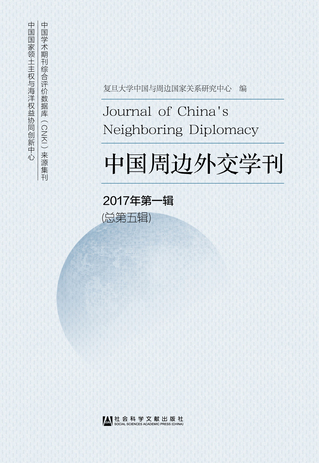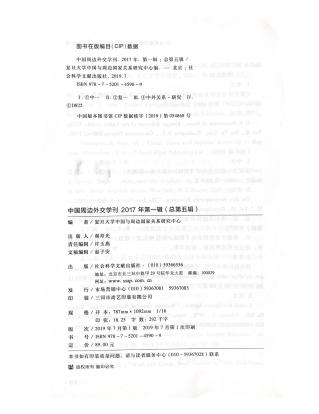Center for China’s Relations with Neighboring Countries of Fudan University (CCRNC-Fudan), ed., Journal of China’s Neighboring Diplomacy, Vol. 3, Issue 1, 2017.
Publisher: Social Sciences Academic Press (China)
Published in July 2019.
ISBN: 978-7-5201-4590-9
The Title Page of Journal of China’s Neighboring Diplomacy, Vol. 3, Issue 1, 2017 |
The Copyright Page ofJournal of China’s Neighboring Diplomacy, Vol. 3, Issue 1, 2017 |
Contents
Preface Qi Huaigao, Bao Xiaqin/1
“The Belt and Road Initiative” Studies
“The Belt and Road Initiative” and the New Ideas for Development
Zhang Yunling/9
“The Belt and Road Initiative” Construction and the China-U.S. Relations
Zhao Minghao/21
China’s Investment in Indonesia within the Framework of “the Belt and Road Initiative”
WU Chongbo/37
Comprehensive Commentary on China’s Neighboring Diplomacy
China's Asia-Pacific Security Cooperation Policy: Its Major Points and Zeitgeist
Shi Yuanhua, Xiao Yang/55
The Evolution of the Ideas for the Security of China’s Neighboring Diplomacy: from Five Principles of Peaceful Coexistence to Asian Security Concept
Gong Lili/79
China’s Relations with Its Neighboring Countries
The Profound Reasons and Future Trends of the Fluctuations of the China-Japan Relations
Wu Jinan/97
China’s Effort to Construct a New Type of Relations with Its Neighboring Countries and Its Policy towards the West Asia
Guo Rui, Fan Congwei/109
Domestic Situations of China’s Neighboring Countries
Japan's Participation in UN Peacekeeping Operations after the Issue of the its New National Security Law: Characteristics of Decision Making and Factors of Restrictions
Zhang Xiaolei/139
Abe Administration’s Effort to Promote the Japan-Russia Relations: The Causes and the Trend
Huang Gang/155
Hot Topics
The Trump Administration, the Korean Nuclear Issue, and China’s Neighboring Diplomacy
Zhang Yun/175
The Issue of Religious Securitization in the United States and Its Influence on the United States Policy towards China: An Observation on the Transformation from Religious Freedom to Religious Terrorism
Liu Qian/190
Book Review
An Outstanding Academic Achievement on the Studies of China’s Neighboring Diplomacy: The Fourteen Lectures on China’s Neighboring Diplomacy by Prof. Shi Yuanhua
Zhong Feiteng/211
Reviews on Symposiums
A Review on the Symposium of “China’s Neighboring Diplomacy in 2016: Evlaution and Prospect”
Li Hongmei and Liu Qingyao/223
A Review on the Symposium of “The Ideas of Generations of Chinese Leaderships on Neighboring Diplomacy”
Gao Mingqiu/234
A Review on the First Symposium of “Cross-Border Ethinic Groups and China’s Neighboring Diplomacy”
Zhao Ying and Lu Fangfang/244
A Review on the Symposium of “Religions and China’s Neighboring Diplomacy against Background of One Belt One Road”
Zhou Lei, Huang Ping, and Tu Yichao/253
A Review on the Symposium of “the Transformation of the China-Japan Relations and the Prospect of East Asia Cooperation”
Lu Shiyi/262
Appendix
Introduction on the Collaborative Innovation Center for Territorial Sovereignty and Maritime Rights (CICTSMR) /271
Introduction on the Center for China’s Relations with Neighboring Countries at the Fudan University (CCRNC) /273
Notice Inviting Contributions to the Journal of China’s Neighboring Diplomacy /275
Manuscript Style and Annotation Specifications of the Journal of China’s Neighboring Diplomacy /277
“The Belt and Road Initiative” and the New Ideas for Development
Zhang Yunling
Abstract:The Silk Road Economic Belt has three major routes that extend in three directions.Its northern route connects East Asia with the Europe through Russia.Its middle route also extends to the Europe,through Central and West Asia.Whereas its southern route meanders to the Maritime Silk Road via the Southeast Asia.On the other hand,the 21st Century Maritime Silk Road has two major directions.One direction is pointed westward to Africa through the South China Sea and the Indian Ocean,while the other direction is oriented towards the South Pacific region.Now the contour and the overall blueprint of “the Belt and Road Initiative” (BRI) have been clearly defined,and tens of thousands of projects are being constructed within in framework of BRI's grand design.The most desired long-term design is to make the whole continent well connected and integrated.In this way,the areas once linked by ancient silk road may be transformed from their underdeveloped state that evolved all the way from early modern history,and the glamorous honor of the ancient silk road may be recreated.Therefore,it is proposed that a new strategic mentality should be created for the BRI construction.More specifically,it is proposed that new ideas shall be adopted to propel the development of China and relevant regions,such as new type of cooperative development and new type of big power relations.It should be pointed out that BRI is a “hundred-year-project” containing historical implications.The BRI idea is developing from a Chinese plan into a worldwide initiative for cooperation.
Author: Zhang Yunling,Member of the National Committee of Chinese People's Political Consultative Conference,Member of the Academic Senate of the Chinese Academy of Social Sciences (CASS) and Director of the Academic Committee of International Relations of CASS.
Official citation: Zhang Yunling, “‘The Belt and Road Initiative’ and the New Ideas for Development”, Journal of China’s Neighboring Diplomacy, Vol. 3, Issue 1, 2017, pp. 9-20.
“The Belt and Road Initiative” Construction and the China-U.S. Relations
Zhao Minghao
Abstract:The United States is not located within the areas covered by “the Belt and Road Initiative”,but it may restrain or even impede the BRI construction.Therefore,it is necessary to handle the difficult issues related to the gaming between big powers in a more effective way,as the BRI is now carried forward steadily and its projects are constructed in details.Particularly,as the U.S.community of strategic studies is paying more and more attention to BRI,more appropriate means should be adopted to deal with its role and influence.In order to monitor and manage the influence of the U.S.on BRI,there is a need to sort out the various strategic concerns of the U.S.on BRI,the specific risks that might be brought by the U.S.once it adopts some measures to restrain China's maneuver for BRI,and the points of possible China-U.S.cooperation for expanding common interests.
Author:Zhao Minghao, Ph.D., Deputy Chief of the Section of Strategic Studies of the Center for Contemporary World Studies, the Department of Foreign Liaisons of the Central Committee of the Chinese Communist Party, Member of China's National Committee for the Council for Security Cooperation of the Asia-Pacific.
Official citation: Zhao Minghao, “‘The Belt and Road Initiative’ Construction and the China-U.S. Relations”, Journal of China’s Neighboring Diplomacy, Vol. 3, Issue 1, 2017, pp. 21-36.
China’s Investment in Indonesia within the Framework of “the Belt and Road Initiative”
WU Chongbo
Abstract:Indonesia's strategy of “global maritime pivot” shares many common points with China's initiative for constructing a 21st Maritime Silk Road,so these two grand plans may benefit each other and jointly provide a broad space for the Indonesia-China bilateral cooperation on economy and trade. As a matter of fact,Indonesia becomes increasingly attractive to Chinese businessmen and Chinese investment in Indonesia is growing at very high speed,in the process of transforming China's “the Belt and Road Initiative” from blueprint into actions. This trend can be attributed to Indonesia's geographical location that may be interpreted as an important strategic pivot for the maritime silk road. Supported by the maturing of the population dividend,the Indonesian market enjoys a very promising future,although it is still faced with many difficulties and challenges. Furthermore,Indonesian government is taking an effort to improve its business environment,and those international rating agencies are uplifting their rating on Indonesian sovereign debts. All these factors help to raise new waves of investment from China. It is estimated that the following sectors of Indonesian economy may offer Chinese investors good chance of earning substantial profits:infrastructure,electricity,information technology, agriculture and food safety, and tourism.
Author:Wu Chongbo, Professor and Ph.D.Tutor of the Research Institute for Southeast Asian Studies, Xiamen University.
Official citation: Wu Chongbo, “China’s Investment in Indonesia within the Framework of ‘the Belt and Road Initiative’”, Journal of China’s Neighboring Diplomacy, Vol. 3, Issue 1, 2017, pp. 37-51.
China's Asia-Pacific Security Cooperation Policy: Its Major Points and Zeitgeist
Shi yuanhua, Xiao Yang
Abstract:On 11 Jan 2007,the Information Office of China's State Council issued a white paper on China's policies on Asia-Pacific security cooperation.This is the first time that China's government publishes a white paper on Asia-Pacific security cooperation policy.The white paper,with the theme “security cooperation”,covers the main issues of the current Asia-Pacific security,illustrates China's policy propositions on Asia-Pacific affairs and responds to China's stance on sensitive issues such as regional hotspots,aiming to give the international community a clearer and more precise understanding of China's Asia-Pacific security cooperation policy.The white paper is divided into China's policies and positions on Asia-Pacific security cooperation,China's security vision for the Asia-Pacific region,China's relations with major Asia-Pacific countries,China's positions and views on regional hotspot issue,China's participation in major multilateral mechanisms in the Asia-Pacific region,China's participation in regional non-traditional security cooperation.After the publication of the white paper,the widespread attention and hot discussion of the media and think tanks from home to abroad have been rapidly aroused.The white paper will have a significant and far-reaching impact on the current complex and volatile Asia-Pacific situation,China's neighboring diplomacy,Asia-Pacific security cooperation and the B&R construction.
Author:Shi Yuanhua,Professor,Director of the Center for China's Relations with Neighboring Countries (CCRNC) at the Fudan University,Deputy Director of China's Collaborative Innovation Center for Territorial Sovereignty and Maritime Rights (CICTSMR).Xiao Yang,Ph.D.Candidate of the China Institute of Boundary and Ocean Studies,Wuhan University.
Official citation: Shi yuanhua, Xiao Yang, “China's Asia-Pacific Security Cooperation Policy: Its Major Points and Zeitgeist”, Journal of China’s Neighboring Diplomacy, Vol. 3, Issue 1, 2017, pp. 55-78.
The Evolution of the Ideas for the Security of China’s Neighboring Diplomacy: from Five Principles of Peaceful Coexistence to Asian Security Concept
Gong Lili
Abstract:Both the Five Principles of Peaceful Coexistence proposed by the first-generation leadership and the Asian Security Concept raised by Xi Jinping,the General Secretary of the CPC Central Committee are the beneficial exploration on the safety philosophy of neighboring diplomacy.They have the succession relationship,stressing on the harmonious coexistence with surrounding nations and the win-win cooperation.From the Five Principles of Peaceful Coexistence proposed by the first-generation leadership to the Asian Security Concept,the safety philosophy of Chinese neighboring diplomacy has been keeping evolving.The safety philosophy of neighboring diplomacy evolves from the focus on military safety to the emphasis on the comprehensive safety;the treatment on the relationship with neighboring nations changes from mutual benefit principle to the bringing benefits to neighboring nations;the target of neighboring diplomacy develops from “peaceful coexistence” to “sustainable safety”.
Author: Gong Lili,associate professor at the School of Public Administration,Jilin University.
Official citation: Gong Lili, “The Evolution of the Ideas for the Security of China’s Neighboring Diplomacy: from Five Principles of Peaceful Coexistence to Asian Security Concept”, Journal of China’s Neighboring Diplomacy, Vol. 3, Issue 1, 2017, pp. 79-93.
The Profound Reasons and Future Trends of the Fluctuations of the China-Japan Relations
Wu Jinan
Abstract:In 2016,the momentum to improve the China-Japan relations,which had been developing for several years in the past,suffered a serious setback.This is because the Japanese rulers made a high-pitched intervention into the territorial disputes over the islands in the South China Sea,escalated the already stressful tensions in the East China Sea,and brought troubles to China's “Belt and Road” construction.This situation once again certified the complexity and endurance of the strategic gaming between China and Japan.The most crucial and fundamental cause leading to the continuous fluctuations of the China-Japan relations is the misperceptions of Japanese rulers in their evaluations over China.It is estimated that competition and challenges will coexist with cooperation and opportunities in the China-Japan relations in the foreseeable future,because it is very difficult to rectify the above-mentioned root cause.
Author:Wu Jinan, Senior Researcher and Deputy Director of the Advisory Committee of the Shanghai Institute of International Studies (SIIS), President of the Shanghai Association of Japanese Studies.
Official citation: Wu Jinan, “The Profound Reasons and Future Trends of the Fluctuations of the China-Japan Relations”, Journal of China’s Neighboring Diplomacy, Vol. 3, Issue 1, 2017, pp. 97-108.
China’s Effort to Construct a New Type of Relations with Its Neighboring Countries and Its Policy towards the West Asia
Guo Rui, Fan Congwei
Abstract:In 2016,the chaos in the West Asia continued.In the meantime,China continued its diplomatic effort in this region.Within the framework of “the Belt and Road Initiative”,China made substantial achievements in its cooperation with the countries in the West Asia in the fields of economy and trade,health care and public hygiene,refugee governance,and information and communication technology.China adopted new measures and concentrated its effort on new focuses.Particularly,China steadily carried forward its B&R Initiative,adopt tough measures to crack down the force of international terrorism,and played a role of mediation between various parties of local conflicts and disputes.In the future,China shall conduct its diplomacy in the West Asia in accordance with the situational changes,and implement new ideas for promoting a new transformation of its relations with the countries in this region.It shall advocate and construct a security view towards the West Asian countries,and manage to establish an awareness among China and West Asian countries for the community of common destiny,so as to convert the West Asia into an important pivot that may support China's “grand neighboring diplomacy”.
Author:Guo Rui, Ph.D. of International Relations, Post-doctorate of Theoretic Economics,Professor and Tutor for Ph.D. Candidate, Department of International Politics, Jilin University; Fan Congwei, Postgraduate for Master's Degree, Department of International Politics, Jilin University.
Official citation: Guo Rui, Fan Congwei, “China’s Effort to Construct a New Type of Relations with Its Neighboring Countries and Its Policy towards the West Asia”, Journal of China’s Neighboring Diplomacy, Vol. 3, Issue 1, 2017, pp. 109-136.
Japan's Participation in UN Peacekeeping Operations after the Issue of the its New National Security Law: Characteristics of Decision Making and Factors of Restrictions
Zhang Xiaolei
Abstract:Three characteristics of Japan's bureaucracy-guided policymaking can be discovered in the process of Japanese government's decision to grant its self-defense force the new missions of peacekeeping:1)The policy orientation is guaranteed by the continuously strengthened bureaucracy-guided policymaking mechanism.2)The policy implementation is operated through a cooperative model characterized by increasingly unhindered political-bureaucratic relations.3)There is a continuously clarified framework regulating the relations between the ruling party and the government,in which the status of the government is higher than that of the ruling party.This framework ensures that the policymaking procedures can be carried forward completely and efficiently.Although the Japanese government already passed a cabinet resolution that grants its self-defense force new missions to participate in the UN peace keeping activities,three factors still restrict the smooth implementation of this new mission:1) It is widely suspected that the new mission granted to Japan's self-defense force may violate Japan's constitution.2)There is a possibility that the members of Japan's self-defense force have to take much more risks than before,which may disturb Japan's general public and make them worried.3) An institutional dilemma already exists in the peace keeping operations of UN.
Author:Zhang Xiaolei,associate professor of the Institute of Japanese Studies,Chinese Academy of Social Sciences.
Official citation: Zhang Xiaolei, “Japan's Participation in UN Peacekeeping Operations after the Issue of the its New National Security Law: Characteristics of Decision Making and Factors of Restrictions”, Journal of China’s Neighboring Diplomacy, Vol. 3, Issue 1, 2017, pp. 139-154.
Abe Administration’s Effort to Promote the Japan-Russia Relations: The Causes and the Trend
Huang Gang
Abstract:Since its inauguration for the second term in 2012,the Abe Administration has been actively promoting its diplomacy towards Russia.It not only takes an effort to upgrade the overall Japan-Russia relations through bilateral cooperation on trade and security,but also attempts to strengthen mutual trust by constant meetings between their respective leaderships.In this way, it does make some achievements.Actually,its actions are driven by multiple motives,such as its desire to settle the problem of its northern territorial disputes with Russia,its hope to sign a Japan-Russia peace treaty,its calculation for economic interests,and its strategy for counter-balancing China.In future,the Japan-Russia relations still faced many impediments,and there is still an uncertainty in the prospect of this bilateral relations.
Author:Huang Gang,Master of International Relations,Researcher of the Shanghai Exchange Center for Japanese Studies.
Official citation: Huang Gang, “Abe Administration’s Effort to Promote the Japan-Russia Relations: The Causes and the Trend”, Journal of China’s Neighboring Diplomacy, Vol. 3, Issue 1, 2017, pp. 155-171.
The Trump Administration, the Korean Nuclear Issue, and China’s Neighboring Diplomacy
Zhang Yun
Abstract:The tension in the Korean Peninsula has been on the rise particularly since 2016 (the year of American presidential election).Facing the rapid technological advances ofDPRK in the nuclear and ballistic-missile programs,the Trump administration has to put the Korean nuclear issue as one top priority in its security and strategic agenda.Due to the failure of economic sanction and strategic patience,the new administration is under the pressure of military deterrence advocates.Meanwhile,Chinese policy toward DPRK is also facing new challenges.On the one hand,China has devoted to its diplomacy with DPRK.On the other hand,the internal and external doubts toward the effectiveness of Chinese diplomacy toward Korea is on the rise.This article seeks the roots of the current dilemma by comparing the post-Cold War Chinese and American diplomacies toward DPRK from the strategic and historical perspective.This article argues that the strategic rationale of the Chinese diplomacy toward DPRK has been sound and consistent.China should stick to this strategic rationale,but more innovative practices might be needed to transform Chinese logic to regional consensus on the Korean Peninsula issue.Korean Peninsula is an important part of Chinese neighboring diplomacy,it is of significance for enriching the strategic thinking and diplomatic practices of Chinese neighboring diplomacy.
Author:Zhang Yun,Associate Professor of National Niigata University,Japan,Research Fellow at Center for Global Governance of Peking University.
Official citation: Zhang Yun, “The Trump Administration, the Korean Nuclear Issue, and China’s Neighboring Diplomacy”, Journal of China’s Neighboring Diplomacy, Vol. 3, Issue 1, 2017, pp. 175-189.
The Issue of Religious Securitization in the United States and Its Influence on the United States Policy towards China: An Observation on the Transformation from Religious Freedom to Religious Terrorism
Liu Qian
Abstract:The theoretic framework of “securitization” offers a new logic for security studies and reveals the “intra-actor” nature of security issue.More importantly,“securitization” provides academic evidence for those actors who control the security discourse and aim at “obtaining a kind of special power by proposing a specific issue that enjoys the highest priority”.In this sense,the religious issue has been lingering in the security agenda of China-U.S.talks as one of the important issues in the China-U.S.relations.Particularly,on this issue,the United States acts as the initiator of securitization and China acts as “a potential passive actor”.Since the end of the cold war,the focus of the United States on religious issues has been shifted from religious freedom to religious terrorism.Against this background,the China-US interactions on religious issues have been transformed from “confrontation” to “cooperation”.
Author:Liu Qian,Associate Professor of the School of Politics and International Relations of the Tongji University.
Official citation:Liu Qian, “The Issue of Religious Securitization in the United States and Its Influence on the United States Policy towards China: An Observation on the Transformation from Religious Freedom to Religious Terrorism”, Journal of China’s Neighboring Diplomacy, Vol. 3, Issue 1, 2017, pp. 190-207.
Link to the Chinese version: http://www.iis.fudan.edu.cn/b8/1e/c11003a178206/page.htm








